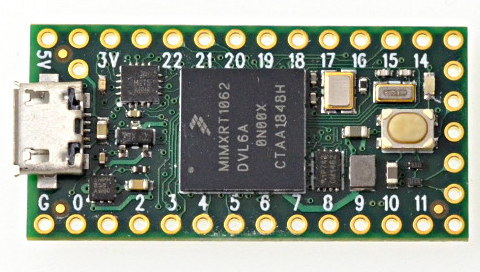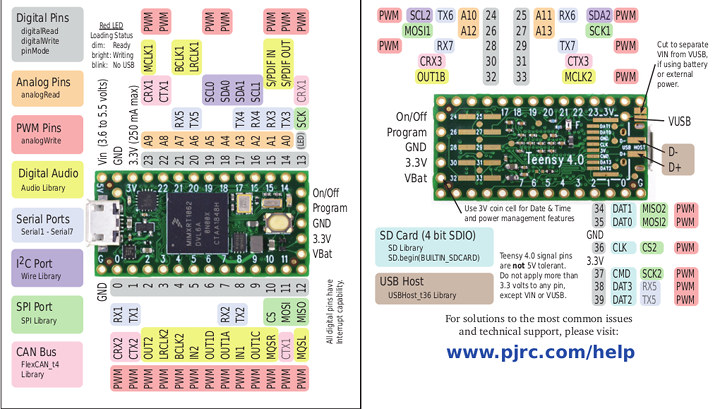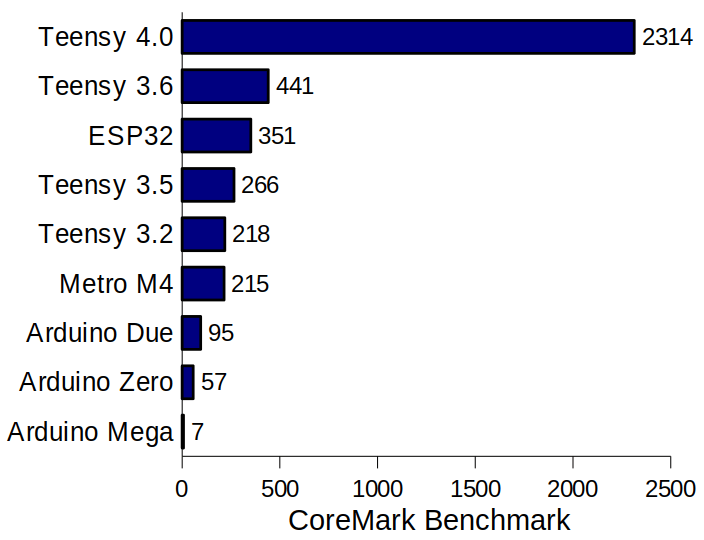We last wrote about Teensy boards in 2016 for the launch of Teensy 3.5 & 3.6 boards powered by NXP Kinetis K64/K66 Arm Cortex-M4 microcontroller, and a longer form factor.
Paul Stoffregen has now upped the ante with Teensy 4.0 featuring a much more powerful NXP i.MX RT1062 Cortex-M7 cross-over processor clocked at 600 MHz, and going back to the original, and more compact, form factor of earlier Teensy boards such as Teensy 3.2.
 Teensy 4.0 hardware specifications:
Teensy 4.0 hardware specifications:
- SoC – NXP i.MX RT1062 Arm Cortex-M7 processor at 600 MHz with 1024KB RAM (512KB is tightly coupled),
- Storage – 2048KB serial flash (64KB reserved for recovery & EEPROM emulation)
- USB – 1x micro USB port for power and programming
- Expansion via through-holes and pads
- USB – 2x USB ports, both 480 MBit/sec
- Storage – 1x SDIO (4 bit) native SD
- Audio – 2x I2S Digital Audio, 1x S/PDIF Digital Audio
- Serial – 7x Serial, all with 4 byte FIFO; 3x CAN Bus (1x with CAN FD)
- 31x PWM pins
- 40x digital pins, all interrupt capable
- 14x analog pins, 2x ADCs on chip
- 3x SPI, all with 16 word FIFO; 3x I2C, all with 4 byte FIFO
- Security – Cryptographic Acceleration; Random Number Generator
- Misc – RTC for date/time, 32x general-purpose DMA channels, Programmable FlexIO, Pixel Processing Pipeline, Peripheral cross triggering, Power On/Off management
- Power Supply – 5V via micro USB port
- Power Consumption – ~100 mA @ 600 MHz
- Dimensions – 3.6 x 1.8 cm

The board is programmable with the Arduino IDE using Teensuino add-on, although currently, you’ll need to use the beta version until v1.47 is released.
The forum post linked also have more details, including several benchmarks, pinout list, and more. Talking about benchmarks, Teensy 4.0 is really much more powerful, as shown by CoreMark results tested with this Arduino sketch.

|
1 2 3 4 5 6 7 8 9 |
Linpack 100x100 mflops double float T4@600mhz 71.4 166.3 gcc -O3 M7@600mhz 66.97 125.5 ARM CC -O3 T3.6@256mhz 2.85 41.1 Fastest T3.6@180mhz 2.13 28.4 Faster T3.2@120mhz 0.65 1.0 Faster no FPU adaM4F@120mhz 1.4 20.1 SAMD51 STM32L4@80mhz 0.88 15.4 dragonfly -O2 |
Price is also a nice surprise. Teensy 3.6 was introduced for $28 via a Kickstarter campaign, but Teensy 4.0 was launched for just $19.95, and quickly ran out of stock. It may take a few weeks before it becomes available again. You’ll find more details and pre-order link on the product page.

Jean-Luc started CNX Software in 2010 as a part-time endeavor, before quitting his job as a software engineering manager, and starting to write daily news, and reviews full time later in 2011.
Support CNX Software! Donate via cryptocurrencies, become a Patron on Patreon, or purchase goods on Amazon or Aliexpress




